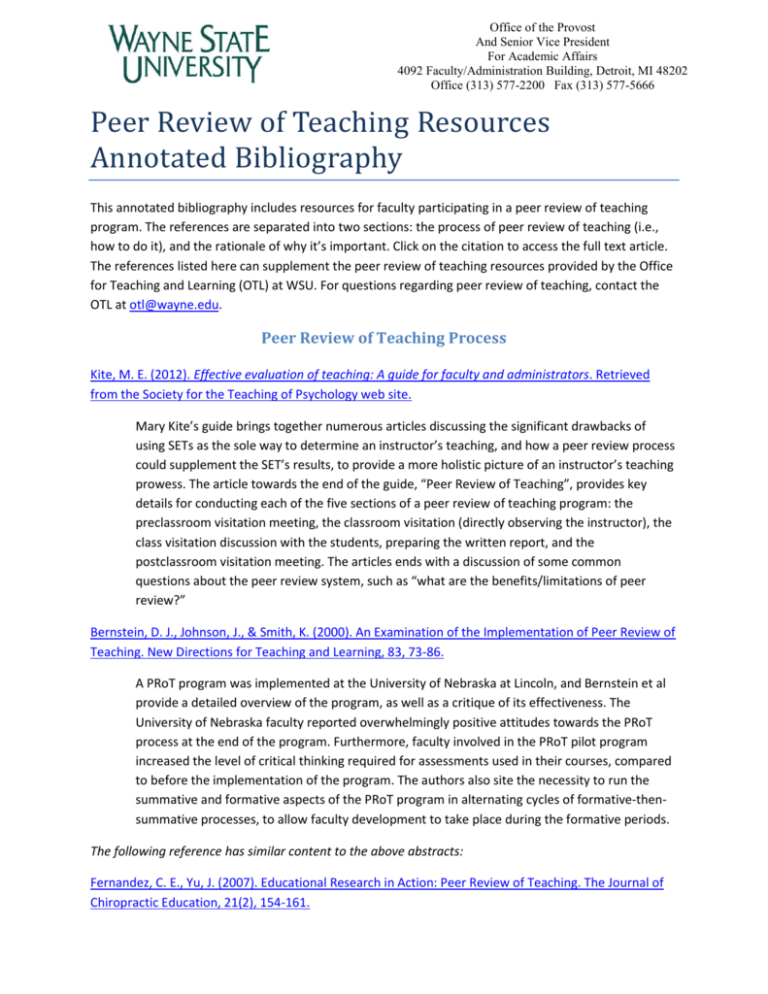Peer Review of Teaching Resources Annotated Bibliography
advertisement

Office of the Provost And Senior Vice President For Academic Affairs 4092 Faculty/Administration Building, Detroit, MI 48202 Office (313) 577-2200 Fax (313) 577-5666 Peer Review of Teaching Resources Annotated Bibliography This annotated bibliography includes resources for faculty participating in a peer review of teaching program. The references are separated into two sections: the process of peer review of teaching (i.e., how to do it), and the rationale of why it’s important. Click on the citation to access the full text article. The references listed here can supplement the peer review of teaching resources provided by the Office for Teaching and Learning (OTL) at WSU. For questions regarding peer review of teaching, contact the OTL at otl@wayne.edu. Peer Review of Teaching Process Kite, M. E. (2012). Effective evaluation of teaching: A guide for faculty and administrators. Retrieved from the Society for the Teaching of Psychology web site. Mary Kite’s guide brings together numerous articles discussing the significant drawbacks of using SETs as the sole way to determine an instructor’s teaching, and how a peer review process could supplement the SET’s results, to provide a more holistic picture of an instructor’s teaching prowess. The article towards the end of the guide, “Peer Review of Teaching”, provides key details for conducting each of the five sections of a peer review of teaching program: the preclassroom visitation meeting, the classroom visitation (directly observing the instructor), the class visitation discussion with the students, preparing the written report, and the postclassroom visitation meeting. The articles ends with a discussion of some common questions about the peer review system, such as “what are the benefits/limitations of peer review?” Bernstein, D. J., Johnson, J., & Smith, K. (2000). An Examination of the Implementation of Peer Review of Teaching. New Directions for Teaching and Learning, 83, 73-86. A PRoT program was implemented at the University of Nebraska at Lincoln, and Bernstein et al provide a detailed overview of the program, as well as a critique of its effectiveness. The University of Nebraska faculty reported overwhelmingly positive attitudes towards the PRoT process at the end of the program. Furthermore, faculty involved in the PRoT pilot program increased the level of critical thinking required for assessments used in their courses, compared to before the implementation of the program. The authors also site the necessity to run the summative and formative aspects of the PRoT program in alternating cycles of formative-thensummative processes, to allow faculty development to take place during the formative periods. The following reference has similar content to the above abstracts: Fernandez, C. E., Yu, J. (2007). Educational Research in Action: Peer Review of Teaching. The Journal of Chiropractic Education, 21(2), 154-161. Rationale for Peer Review of Teaching Atkinson, D. J., & Bolt, S. (2010). Using teaching observations to reflect upon and improve teaching practice in higher education. Journal of the Scholarship of Teaching and Learning, 10(3), 1-9. Atkinson and Bolt discuss the implementation of a PRoT program, specifically calling on a formative approach involving peer observation to promote faculty reflection on their teaching. This PRoT process involved an observation of the faculty teaching by an expert observer, a written report by the observer, a post-observation discussion between the observer and faculty member, and a group debrief. The group debrief was somewhat unique to this PRoT process, and involved all faculty and observers sharing knowledge regarding the experience. Atkinson and Bolt found that the faculty recommended the process be continued in a voluntary manner, and that the observer be a university retained expert. Bernstein, D. J. (2008). Peer Review and Evaluation of the Intellectual Work of Teaching. Change: The Magazine of Higher Learning, 40 (2), 48-51. Daniel Bernstein provides a review of the roots of the general PRoT process and ideals, and many issues associated with the process. Bernstein offers insight from several sources to tackle the emerging issues in establishing PRoT programs, such as the necessary support of faculty development activities in concert with the establishment of PRoT programs. Furthermore, Bernstein discusses sources that stress the importance of keeping formative and summative PRoT programs separate. Bernstein ends by discussing sources commenting on the integration of PRoT programs into larger faculty evaluation structures at universities. Maeda, M., Sechtem, P. R., & Scudder, R. (2009). Peer Review of Teachers: Are They Useful? Paper presented at the 5th Annual GRASP Symposium, Wichita State University. Maeda et al. performed a short study aimed to learn more about methods and uses of information from peer reviews of teaching, specifically in the Communication Sciences and Disorders programs. The study included a survey of instructors (115) from 85 programs, and the survey included similar to “Are the results of peer reviews meaningful to you?”, and “Do you take peer reviews to heart and change or modify the way you teach based on the findings?”, etc. The study shows that the peer review process has an overall positive impact, with 80% of the respondents stating that the results of the peer reviews were meaningful to them. Prepared by the Office for Teaching and Learning for the 2N Committee on Peer Review, Wayne State University, Fall 2014








